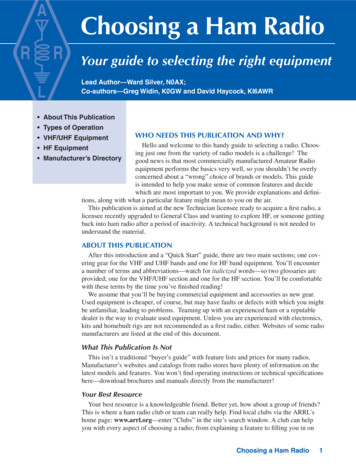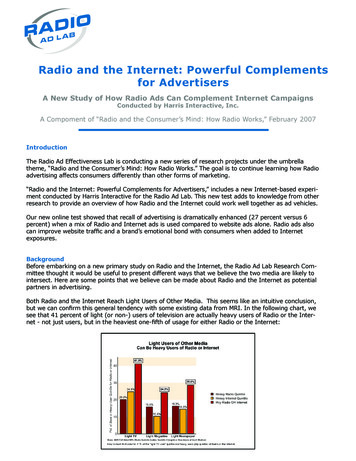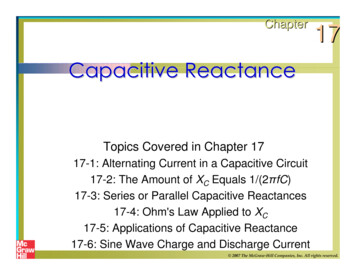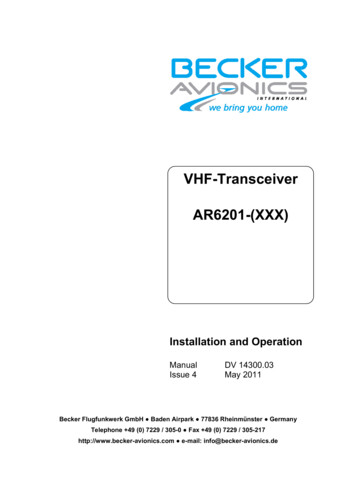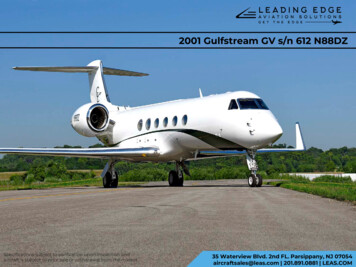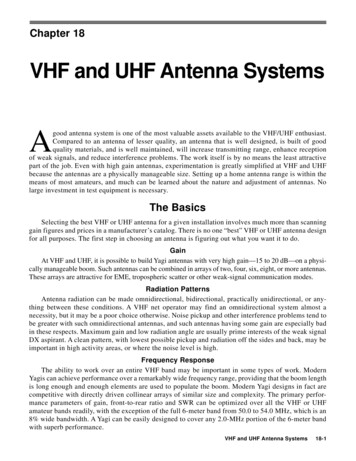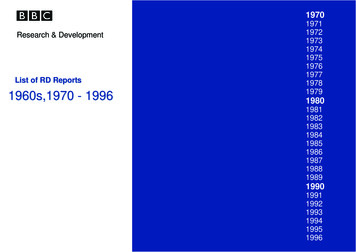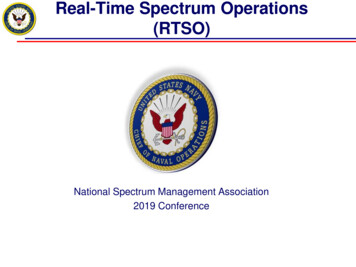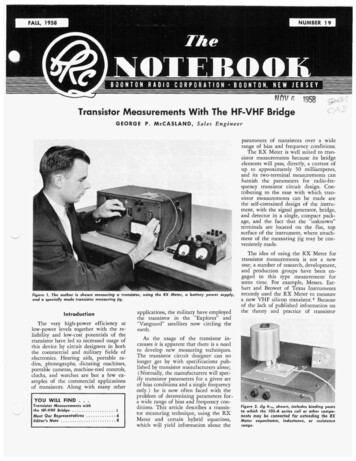
Transcription
TY91/TY92 VHF radioInstallation Manual00839-00-AE28 April 2014Trig Avionics LimitedHeriot Watt Research ParkRiccarton, EdinburghEH14 4APScotland, UKCopyright Trig Avionics Limited, 2013, 2014
This page intentionally left blank
TY91/TY92 VHF Radio Installation Manual00839-0028 April 2014Issue AECONTENTS1.2.3.4.PREFACE.51.1PURPOSE .51.2SCOPE .51.3CHANGES FROM PREVIOUS ISSUE.51.4DOCUMENT CROSS-REFERENCES .5INTRODUCTION .72.1TY91/TY92 DESCRIPTION .72.2INTERFACES .72.2.1TY91/TY92 VHF radio Unit .72.2.2TC90 Controller Unit.8TECHNICAL SPECIFICATIONS .93.1TY91 VHF RADIO UNIT (00882-00-01) .93.2TY92 VHF RADIO UNIT (00879-00-01) .103.3TC90 CONTROL UNIT (00857-00-01) .123.4LOW VOLTAGE OPERATION .123.5INSTALLATION APPROVAL .13UNIT AND ACCESSORIES SUPPLIED .144.1TY91 VHF RADIO ITEMS .144.2TY92 VHF RADIO ITEMS .144.3TC90 CONTROLLER ITEMS.144.4INSTALLATION KIT .144.5REQUIRED ITEMS .15Trig Avionics Limitedi
TY91/TY92 VHF Radio Installation Manual00839-005.28 April 2014Issue AEINSTALLATION.165.1UNPACKING AND INSPECTING EQUIPMENT .165.2CONTROLLER MOUNTING .165.3VHF RADIO MAIN UNIT MOUNTING .175.4COOLING REQUIREMENTS .175.5TY91/TY92 VHF RADIO ELECTRICAL CONNECTIONS .185.5.15.6TY91/TY92 Interface – Pinout.18TY91/TY92 VHF RADIO INTERFACE DETAILS.195.6.1Speaker Output.195.6.2TMAP Bus .195.6.3Headphone Output .205.6.4Controller Power .205.6.5Power On .205.6.6PTT1/2 Key Input.205.6.7Intercom Key Input .215.6.8Transmit Interlock.215.6.9Auxiliary Audio Input.215.6.10Microphone Input.225.6.11Power Input.225.6.12Ground Returns.225.7TC90 CONTROLLER ELECTRICAL CONNECTIONS .225.7.15.8TC90 Interface - Pinout .23TC90 CONTROLLER INTERFACE DETAILS .245.8.1TMAP Bus .24iiTrig Avionics Limited
TY91/TY92 VHF Radio Installation Manual00839-005.8.2RS232 Input.245.8.3Remote ON .245.8.4Power .245.8.5Step Button .245.8.6Transfer Button .255.9D CONNECTOR CRIMP TERMINALS .255.10WIRING CONSIDERATIONS .265.10.1TC90 Interconnect .265.10.2Audio wiring.275.116.28 April 2014Issue AEANTENNA INSTALLATION .285.11.1Antenna Ground Plane .285.11.2Antenna Cable.295.11.3TNC Connector .29INSTALLATION SETUP AND TEST .316.1INITIAL POWER ON .316.2CONFIGURATION ITEMS .316.2.1Intercom Volume.326.2.2Intercom Squelch .326.2.3Auxiliary Input Volume .326.2.4Auxiliary Input Muting.326.2.5Sidetone Volume.326.2.6Receiver Squelch Offset .326.2.7Frequency Step Size .336.2.8Display Brightness .33Trig Avionics Limitediii
TY91/TY92 VHF Radio Installation Manual00839-006.2.928 April 2014Issue AEMicrophone gain adjustment .337.POST INSTALLATION CHECKS.348.NORMAL OPERATION .358.1OVERVIEW .358.2DISPLAY .358.3ON/OFF VOLUME KNOB .358.4TUNING KNOBS .368.5FLIP-FLOP BUTTON .368.6MON BUTTON .368.7MEM BUTTON .368.8GENERAL LOW TEMPERATURE OPERATION .378.9WARNING MESSAGES .378.10FAULT ANNUNCIATION .379.CONTINUED AIRWORTHINESS .399.1CLEANING THE TC90 CONTROLLER .3910.LIMITED WARRANTY.4011.ENVIRONMENTAL QUALIFICATION FORMS.4112.INSTALLATION DRAWINGS .4712.1MOUNTING TRAY FIXING AND OVERALL DIMENSIONS .4712.2FRONT PANEL CONTROLLER DIMENSIONS .4812.3FRONT PANEL CUT-OUT OPTIONS .4913.WIRING DIAGRAMS .51ivTrig Avionics Limited
TY91/TY92 VHF Radio Installation Manual00839-0028 April 2014Issue AE1. Preface1.1 PurposeThis manual describes the physical and electrical characteristics and theinstallation requirements for a TY91/TY92 VHF radio and associatedcontroller.1.2 ScopeThis document applies to the installation of the TY91 and TY92 VHF radio.This manual applies to TY91/TY92 software version 1.5 or later and TC90controller software version 1.3 or later. The software versions and FPGA aresubject to change without notice.1.3 Changes from Previous IssueChanges from Issue AD to Issue AE are:Section 6.2.9Added a section for microphone sensitivity adjustmentSection 7Added post installation check for microphone gain settingSection 8Modified the warnings section for automatic and manualclearing of warnings1.4 Document Cross-References00840-00TY91 VHF radio Operating ManualACETSO 2C169aVHF Radio communication receiving equipmentoperating within the radio frequency range117.875 – 137 MHzEASATrig Avionics Limited5
TY91/TY92 VHF Radio Installation Manual00839-0028 April 2014Issue AETSO C169aMinimum Operational Performance standards forAirborne Radio Communications equipmentstandardsFAAETSO 2C128Devices that prevent blocked channels used intwo-way radio communications due tounintentional transmissionsEASATSO C128aEquipment that prevents blocked channels usedin two-way radio communications due tounintentional transmissionsFAA6Trig Avionics Limited
TY91/TY92 VHF Radio Installation Manual00839-0028 April 2014Issue AE2. Introduction2.1 TY91/TY92 DescriptionThe TY91/TY92 VHF radio system is an ED-23C compliant class C (25 kHzoffset carrier) and class E (8.33 kHz single carrier) VHF radio. The TY91 hasa nominal power output of 6 watts, and meets the power output requirementsfor Class 4 and Class 6. The TY92 has a nominal power output of 16 watts,and meets the power output requirements for Class 3 and Class 5. TheTY91/TY92 is certified to ETSO 2C169a 2C128a, TSO C169a and TSOC128a.The TY91 and TY92 VHF radios are controlled using a separate front panelcontroller, called the TC90. This allows the radio to be mounted separatelyfrom the instrument panel, and reduces the amount of panel space taken by theVHF radio. The TC90 is certified to ETSO 2C169a, and TSO C169a.The TY91 runs from either a 14 volt nominal or 28 volt nominal DC powersupply with no configuration changes required. The TY92 requires a 28 voltnominal supply.2.2 Interfaces2.2.1 TY91/TY92 VHF radio UnitThe main VHF radio unit has a single TNC antenna connection and a single 25way D-type connector. The 25 way D-type interface provides the followingservices:Power InputThe TY91 operates on 11 to 33 volts DC. The TY92operates on 22 to 33 volts DC.Front Panel DatalinkA two wire data link is used to connect the TY91/TY92and the controller.Front Panel PowerThe controller is powered from the VHF radio.Trig Avionics Limited7
TY91/TY92 VHF Radio Installation Manual00839-0028 April 2014Issue AERemote On/OffThe on-off switch is on the TC90 controller, and uses thisinput to turn the radio on or off.Microphone inputsThere are two microphone inputs, suitable forconventional aircraft microphones.Push-to-talk inputsThere are two push to talk inputs corresponding to thetwo microphones.Headphone outputA headphone output suitable for conventional aircraftheadsets with impedance in the region of 150 ohms.Speaker outputA speaker output suitable for a cabin speaker withimpedance of 4 ohms or greater.Intercom keyswitchAn optional input to allow the intercom to be switchcontrolled.Auxiliary audioinputA single connection to allow audio annunciators or identtones to be routed to the headphones and speaker.2.2.2 TC90 Controller UnitThe TC90 controller has a single 15 way D-type connector. It provides thefollowing services:Power InputThe controller receives power from the VHF radio.Front Panel DatalinkA two wire data link is used to connect theTY91/TY92 and the controller.Remote On/OffThe on-off switching is on the controller, and controlsthis output.External switchinputsOptional keyswitch inputs to enable remote transferand frequency steppingSerial inputOptional input to allow preloading of frequencies,generally from a GPS.8Trig Avionics Limited
TY91/TY92 VHF Radio Installation Manual00839-0028 April 2014Issue AE3. Technical Specifications3.1 TY91 VHF Radio Unit eETSO 2C169a Class C, E, H1, H2, 4, 6, ETSO2C128, TSO C169a Class C, E, 4, 6, TSOC128aFCC IdentificationVZI00882Applicable documentsEUROCAE ED-23C, EUROCAE ED-67,EUROCAE ED-14F (RTCA DO-160F),RTCA DO-186B, RTCA DO-207SoftwareED-12B (RTCA DO-178B) Level BHardwareDO-254 Level CPower Requirements11 – 33 volts DC. Typical 2.8 watts @14volts, receive; typical 28 watts @ 14 volts,transmit. Maximum current 3.2A.Altitude55,000 feetHumidity95% @ 50 C for 6 hours; 85% @ 38 C for16 hours.Tested to Category A in DO-160FOperating Temperature-20 C to 70 CTransmitter Frequency118.000 MHz to 136.992 MHz; 760 channelsat 25 kHz spacing, 2280 channels at 8.33 kHzspacing.Transmitter Power6 watts nominal carrier powerTransmitter Modulation5K6 A3EStuck-mic timeout35 secondsTrig Avionics Limited9
TY91/TY92 VHF Radio Installation Manual00839-0028 April 2014Issue AETransmitter Duty Cycle100% transmit is possible (subject to stuck mictimeout)Receiver Frequency118.000 MHz to 136.992 MHz; 760 channelsat 25 kHz spacing, 2280 channels at 8.33 kHzspacing.Receiver Sensitivity 5uV for 6 dB SINADAGC Characteristic 6dB variation 5 uV to 100 mV EMFPhysical Specifications (in the mounting tray)Height48mm (1.9”)Width66mm (2.5”)Length160mm (6.3”)Weight0.77lbs. (350 g)3.2 TY92 VHF Radio Unit eETSO 2C169a Class C, E, H1, H2, 3, 5, ETSO2C128, TSO C169a Class C, E, 3, 5, TSOC128aFCC IdentificationVZI00879Applicable documentsEUROCAE ED-23C, EUROCAE ED-67,EUROCAE ED-14F (RTCA DO-160F),RTCA DO-186B, RTCA DO-207SoftwareED-12B (RTCA DO-178B) Level BHardwareDO-254 Level CPower Requirements22 – 33 volts DC. Typical 2.8 watts @28volts, receive; typical 80 watts @ 28 volts,transmit. Maximum current 3.2A.10Trig Avionics Limited
TY91/TY92 VHF Radio Installation Manual00839-0028 April 2014Issue AEAltitude55,000 feetHumidity95% @ 50 C for 6 hours; 85% @ 38 C for16 hours.Tested to Category A in DO-160FOperating Temperature-20 C to 55 CTransmitter Frequency118.000 MHz to 136.992 MHz; 760 channelsat 25 kHz spacing, 2280 channels at 8.33 kHzspacing.Transmitter Power16 watts nominal carrier powerTransmitter Modulation5K6 A3EStuck-mic timeout35 secondsTranmitter Duty Cycle50% duty cycle – 35 seconds on followed by35 seconds off.Receiver Frequency118.000 MHz to 136.992 MHz; 760 channelsat 25 kHz spacing, 2280 channels at 8.33 kHzspacing.Receiver Sensitivity 5uV for 6 dB SINADAGC Characteristic 6dB variation 5 uV to 100 mV EMFPhysical Specifications (in the mounting tray)Height48mm (1.9”)Width66mm (2.5”)Length160mm (6.3”)Weight0.77lbs. (350 g)Trig Avionics Limited11
TY91/TY92 VHF Radio Installation Manual00839-0028 April 2014Issue AE3.3 TC90 Control Unit eETSO 2C169a, TSO C169aApplicable documentsEUROCAE ED-23C, EUROCAE ED-14F (RTCADO-160F), RTCA DO-186BSoftwareED-12B (RTCA DO-178B) Level BAltitude35,000 feetHumidity95% @ 50 C for 6 hours; 85% @ 38 C for 16hours. Tested to Category A in DO-160FOperating Temperature-20 C to 55 CPhysical Specifications (behind the panel)Height44mm (1.8”)Width63mm (2.4”)Length54mm (2.1”)Weight0.11lbs. (90 g)3.4 Low Voltage OperationNormal operating voltage for the TY91 is any voltage between 11 and 33volts, whilst normal operating voltage for the TY92 is any voltage between 22and 33 volts. At these voltages all functions behave normally, and transmitterpower meets the applicable Class requirements of ED-23C.The radio will continue to operate at a lower voltage than these ranges. As theavailable voltage falls, the transmitter output power will be reduced, and at 9volts the nominal transmitter power will be approximately 2.5 watts. Thetransmitter will be inhibited below 8 volts.The receiver also works below the nominal voltage. All receiver functionswill work normally, but as a safety feature to preserve battery power in anemergency, at 10 volts or below the available speaker volume will reduce12Trig Avionics Limited
TY91/TY92 VHF Radio Installation Manual00839-0028 April 2014Issue AEsignificantly.In addition a warning message, “Low Volts”, will be displayed on thecontroller when the bus voltage falls below 10 volts in a TY91, or 18 volts in aTY92.3.5 Installation ApprovalThe conditions and tests required for the TSO approval of the TY91/TY92VHF radio are minimum performance standards. It is the responsibility ofthose installing this VHF radio on or within a specific type or class of aircraftto determine that the aircraft operating conditions are within the TSOstandards. The VHF radio may be installed only if further evaluation by theuser/installer documents an acceptable installation that is approved by theappropriate airworthiness authority.Trig Avionics Limited13
TY91/TY92 VHF Radio Installation Manual00839-0028 April 2014Issue AE4. Unit and Accessories supplied4.1 TY91 VHF radio ItemsThe TY91 VHF radio includes the following items:Unit DescriptionQtyPart NumberTY91 VHF radio100882-00-01TY91/TY92 Mounting Tray100667-004.2 TY92 VHF radio ItemsThe TY92 VHF radio includes the following items:Unit DescriptionQtyPart NumberTY92 VHF radio100879-00-01TY91/TY92 Mounting Tray100667-004.3 TC90 Controller ItemsThe TC90 controller includes the following items:Unit DescriptionQtyPart NumberTC90 VHF radio Controller100857-00-01TY91/TY92 Installation Kit100864-004.4 Installation KitThe TY91/TY92 installation kit includes the following items:14Trig Avionics Limited
TY91/TY92 VHF Radio Installation Manual00839-00Unit Description28 April 2014Issue AEQtyPart NumberTY91/TY92 VHF radio InstallationManual100839-00TY91/TY92 Pilots Operating Manual100840-00Mounting adapter (circular hole adapter)200678-00Connector Co-axial TNC100723-00Headshell, 15 way100867-00Headshell, 25 way100726-0015 way D-type contact housing (female)100865-0025 way D-type contact housing (female)100866-00Crimp Terminal, Female, 22-24 AWG4000730-00Long mounting screws, 4-40 thread400736-00Short mounting screws, 4-40 thread400737-004.5 Required ItemsAdditional items you will require, but which are not in the TY91/TY92package, include: Antenna and fixing hardware. The TY91/TY92 is compatible withany standard 50 ohm vertically polarised antenna with a VSWR betterthan 2.5:1. Cables. You need to supply and fabricate all required cables.Guidance on cable types is given in section 5 below. Fixings. To secure the VHF radio tray to the airframe you will needat least 3 flat head screws and three self-locking nuts. If the aircraftdoes not have existing mounting provisions you may need to fabricateadditional brackets to support the VHF radio tray.Trig Avionics Limited15
TY91/TY92 VHF Radio Installation Manual00839-0028 April 2014Issue AE5. Installation5.1 Unpacking and Inspecting EquipmentCarefully unpack the VHF radio and make a visual inspection of the unit forevidence of any damage incurred during shipment. If the unit is damaged,notify the shipping company to file a claim for the damage. To justify yourclaim, save the original shipping container and all packaging materials.5.2 Controller MountingThe TC90 VHF radio controller must be mounted rigidly in the aircraft panel.The controller can be mounted in the ultra compact mounting hole or in aconventional 57mm (2¼ inch) instrument cut-out.The following installation procedure should be followed, remembering toallow adequate space for installation of cables and connectors. Select a position in the panel that is not too close to any high externalheat source. (The TC90 is not a significant heat source itself anddoes not need to be kept away from other devices for this reason).Don’t forget that on some aircraft the canopy can focus the sun ontothe panel and make the controller very hot. Avoid sharp bends and placing the cables too near to the aircraftcontrol cables.If you are using a 57mm instrument cut-out, you must first clip the twomounting adapters to the controller. The controller should then be mountedusing the four LONG screws provided.Note: The mounting adapters are held in place by the clampingaction of the panel installation. As an aid to securing them duringassembly when access is poor, we recommend putting a rubber bandaround the adapters and the control head. The rubber band can besnipped off and discarded when the installation is complete.If you are using the Trig compact cut-out, you do not need the mounting16Trig Avionics Limited
TY91/TY92 VHF Radio Installation Manual00839-0028 April 2014Issue AEadapters. The controller should be mounted using the four SHORT screwsprovided. The screws supplied are appropriate for panel thicknesses from 3mm to 5 mm. If a thinner panel is used, you may need to exchange the screwsfor shorter versions since they can bottom out in the mounting holes.If alternate screws are required, please note that the mounting thread in eachcase is 4-40.5.3 VHF Radio Main Unit MountingThe TY91/TY92 VHF radio is designed to be mounted in any convenientlocation in the cockpit, the cabin, or an avionics bay.The following installation procedure should be followed, remembering toallow adequate space for installation of cables and connectors. Select a position in the aircraft that is not too close to any highexternal heat source. (The TY91/TY92 can become warm to thetouch itself). Avoid sharp bends and placing the cables too near to the aircraftcontrol cables. Secure the mounting tray (p/n 00667-00) to the aircraft via the three(3) mounting holes in the tray. The tray should be mounted to a flatsurface - it is important that the tray is supported at the two dimplesas well as the three mounting points. Put the TY91/TY92 VHF radio into the secured mounting tray byhooking the connector end under the lip on the tray. Lock the TY91/TY92 VHF radio into the mounting tray by clippingthe retaining wire over the lugs on the opposite end.5.4 Cooling RequirementsThe TY91/TY92 VHF radio meets all applicable ETSO requirements withoutforced air-cooling. Reasonable air circulation should be provided.Attention should be given to the incorporation of cooling provisions to limitTrig Avionics Limited17
TY91/TY92 VHF Radio Installation Manual00839-0028 April 2014Issue AEthe maximum operating temperature if the TY91/TY92 is installed in closeproximity to other avionics. The reliability of equipment operating in closeproximity in an avionics bay can be degraded if adequate cooling is notprovided.5.5 TY91/TY92 VHF Radio Electrical ConnectionsThe TY91/TY92 has a single 25 way male socket which provides the audio,data and power inputs to the VHF radio. A single TNC coaxial connectorattaches to the antenna.5.5.1 TY91/TY92 Interface – PinoutPinSignalDirection1Speaker Return2Speaker Out3TMAP1ABidirectional4TMAP1BBidirectional5RS232 InInput6RS232 Ground-10Headphone Return-11Headphone OutOutput12Controller PowerOutput13Power ONInput14PTT2 KeyInput15PTT1 KeyInputOutput18Trig Avionics Limited
TY91/TY92 VHF Radio Installation Manual00839-0028 April 2014Issue AE16Reserved-17Intercom KeyInput18Transmit InterlockInput19Ground20Aux AudioInput21Microphone 2Input22Ground23Microphone 124Aircraft Power (DC)-25Aircraft Power (DC)--InputThe following diagram shows the connector orientation as viewed from thewiring side.5.6 TY91/TY92 VHF Radio Interface Details5.6.1 Speaker OutputThe speaker output can drive a 4 ohm or 8 ohm cabin speaker. The speakershould be rated at 4 watts or higher.5.6.2 TMAP BusTMAP is a Trig proprietary bus based on RS485 signalling. It provides a biTrig Avionics Limited19
TY91/TY92 VHF Radio Installation Manual00839-0028 April 2014Issue AEdirectional interface between the VHF radio and the control head. EachTMAP interface comprises a balanced pair of signals, called A and B, both ofwhich must be connected for communication to work.There are two sets of TMAP pins on the TY91/TY92, TMAP1 A and B, andTMAP2 A and B.On the TY91 and TY92 TMAP1 and TMAP2 are wired together internally.The two sets are identical, and either pair (TMAP1 or TMAP2) may be used toconnect to the control head.5.6.3 Headphone OutputThe headphone output is intended to drive one or two sets of 300 to 600 ohmheadphones which may be connected in parallel, or to drive a conventional600 ohm audio panel input.5.6.4 Controller PowerThe TC90 controller does not connect to aircraft power – it receives powerfrom the TY91/TY92 using this output. The TY91/TY92 provides 12 volts tothe TC90. This output includes short circuit protection, and no fuse isrequired between the TY91/TY92 and the TC90.5.6.5 Power OnThe TY91/TY92 power supply is controlled by this discrete input. The inputis active low, so that the TY91/TY92 will power up whenever the input is heldlow. This signal is intended to connect to the TC90 Remote ON output.5.6.6 PTT1/2 Key InputTwo Push to Talk (PTT) inputs are provided, which correspond to the twomicrophone inputs. Only the corresponding microphone input is routed to thetransmitter when the key switch is pressed.The PTT1 input has priority over the PTT2 input – if the PTT1 switch isclosed when the PTT2 switch is closed, the input from Microphone 1 is routed20Trig Avionics Limited
TY91/TY92 VHF Radio Installation Manual00839-0028 April 2014Issue AEto the transmitter.The inputs are active low, and will be asserted when the voltage to ground ispulled below approximately 4 volts. The input should be connected to amomentary switch on the yoke or on the microphone.5.6.7 Intercom Key InputThe intercom key switch input allows the intercom function to be selectedusing a remote switch, or permanently enabled by grounding the pin inside theconnector. The input is active low, and will be asserted when the voltage toground is pulled below approximately 4 volts.If this pin is tied low, the intercom function depends on the vox operatedsquelch.Note: It is possible to combine both the key switch and the voxactivation, or to use only one. To use only the switch, wire the switchto the intercom key input and select the vox squelch to the lowestsetting during configuration. To use only the vox, wire the intercomkey input to ground, and configure the squelch accordingly.5.6.8 Transmit InterlockWhen two VHF radios are mounted in an aircraft the transmit interlock inputof one can be connected to the transmit PTT key of the other radio. When theother radio transmitter is keyed, the squelch threshold of this radio is increasedto minimise break-through between one radio and the other.Note: To improve the performance when using two radios, theantennas should be as far apart as practical – for example on the topand bottom of the fuselage.5.6.9 Auxiliary Audio InputThis input is continually routed to the headphone and cabin speaker outputs. Itis intended for annunciators and identification tones.Note: The audio bandwidth on the auxiliary input is limited, and isTrig Avionics Limited21
TY91/TY92 VHF Radio Installation Manual00839-0028 April 2014Issue AEnot ideal for MP3 players or other entertainment inputs. If such adevice is connected, the mute settings should be enabled inconfiguration mode so that radio reception and transmission takespriority over the music input.5.6.10 Microphone InputMicrophone connections should be made using shielded twisted pair cables.The two microphone inputs are identical, and have a nominal sensitivity of100 mV into a 600 ohm load. A bias voltage is supplied by the radio to themicrophone inputs to support a preamplifier in the microphone.5.6.11 Power InputThe TY91 power supply can be 11-33 volts DC; no voltage adjustment isrequired. The TY92 power supply must be 22-33 volts DC. Use a 5 Ampcircuit breaker for power supply protection to the TY91 and TY92.The peak current consumption on transmit exceeds the current capability of asingle pin on the connector. Both power inputs must be wired, and at least twoground returns must be wired. This is particularly important when the VHFradio is mounted on a non-conducting surface, such as a composite structure.Use 20 AWG wire for the power connection wires.5.6.12 Ground ReturnsThere are only 5 ground pins on the 25 way connector, at pins 1, 9, 10, 19 and22. A full wiring loom with speaker, two headsets, two microphones, theTC90 connection, power and ground requires 9 ground connections. It istherefore necessary to double up connections to ground pins. This is usuallyachieved by bringing a short ground wire from a pin that then acts as a buspoint inside the D shell.5.7 TC90 Controller Electrical ConnectionsThe TC90 controller has a single 15 way D type male connector to link to theVHF radio, and optionally to connect to a GPS for loading frequencies of22Trig Avionics Limited
TY91/TY92 VHF Radio Installation Manual00839-0028 April 2014Issue AEnearby airfields.5.7.1 TC90 Interface - PinoutPinSignalDirection1Gro
EUROCAE ED-14F (RTCA DO-160F), RTCA DO-186B, RTCA DO-207 . Software . ED-12B (RTCA DO-178B) Level B . Hardware . DO-254 Level C . Power Requirements . 11 - 33 volts DC. Typical 2.8 watts @ 14volts, receive; typical 28 watts @ 14 volts, transmit. Maximum current 3.2A. Altitude .
